Challenges and Solutions for Increasing Type 2 Diabetes Rate
VerifiedAdded on 2020/10/22
|7
|1677
|61
Essay
AI Summary
This essay delves into the critical issue of the increasing rate of type 2 diabetes, a major global health concern. It begins by highlighting the prevalence and impact of the disease, emphasizing the challenges faced both locally and globally. The essay critiques the current situation, pointing out the key reasons behind the rise in type 2 diabetes, such as poor lifestyle choices and lack of awareness. It then explores specific challenges faced by health professionals, including resource limitations and insufficient awareness programs, proposing solutions such as government initiatives to provide resources and awareness campaigns. From a global perspective, the essay addresses challenges like limited knowledge and inefficient healthcare infrastructure, suggesting collaborative efforts between developed countries and international organizations to create awareness, conduct research, and support countries with limited resources. The essay concludes by emphasizing the importance of shared responsibility among professional communities to effectively tackle the rising rate of type 2 diabetes at both local and global levels, ensuring comprehensive solutions and improved health outcomes.

ESSAY
Paraphrase This Document
Need a fresh take? Get an instant paraphrase of this document with our AI Paraphraser
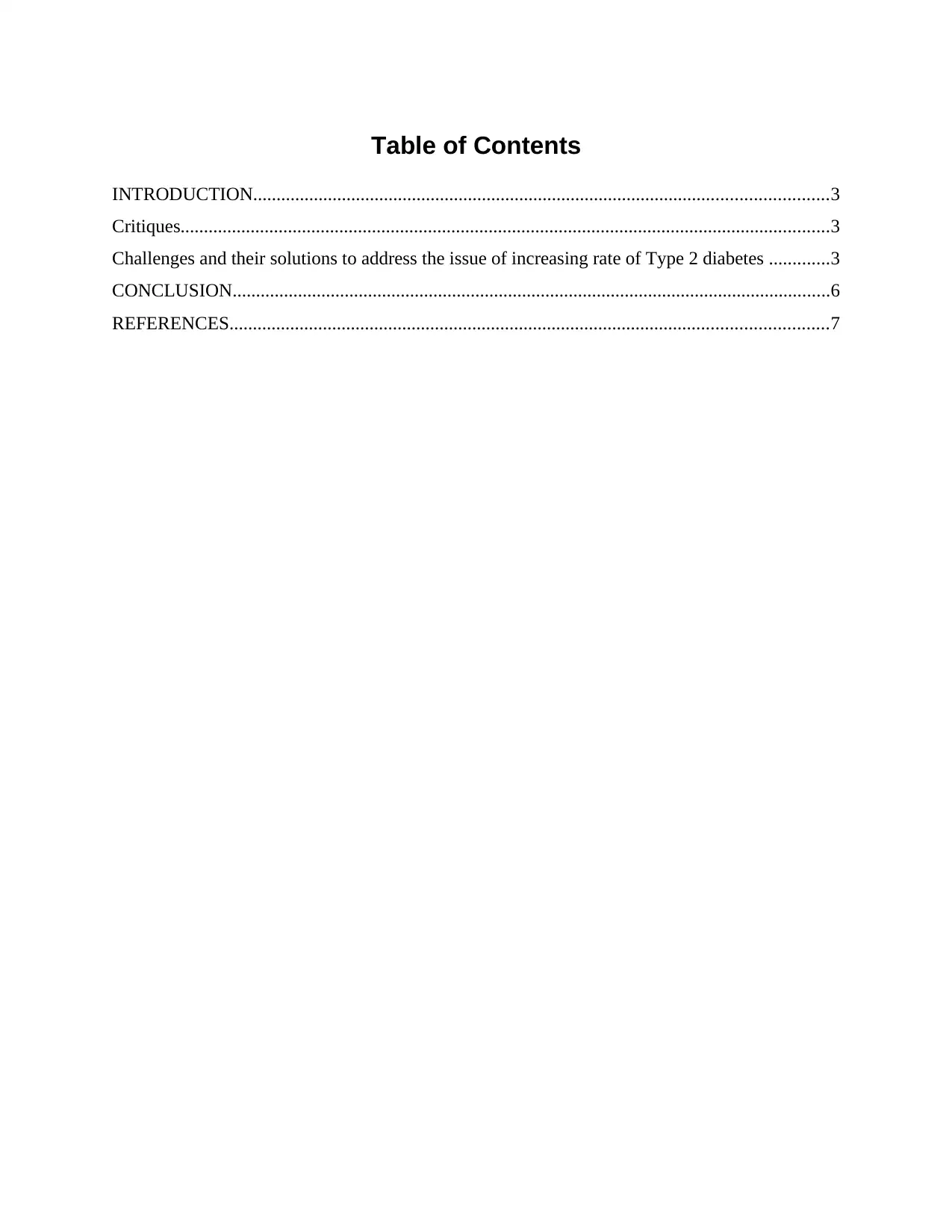
Table of Contents
INTRODUCTION...........................................................................................................................3
Critiques...........................................................................................................................................3
Challenges and their solutions to address the issue of increasing rate of Type 2 diabetes .............3
CONCLUSION................................................................................................................................6
REFERENCES................................................................................................................................7
INTRODUCTION...........................................................................................................................3
Critiques...........................................................................................................................................3
Challenges and their solutions to address the issue of increasing rate of Type 2 diabetes .............3
CONCLUSION................................................................................................................................6
REFERENCES................................................................................................................................7
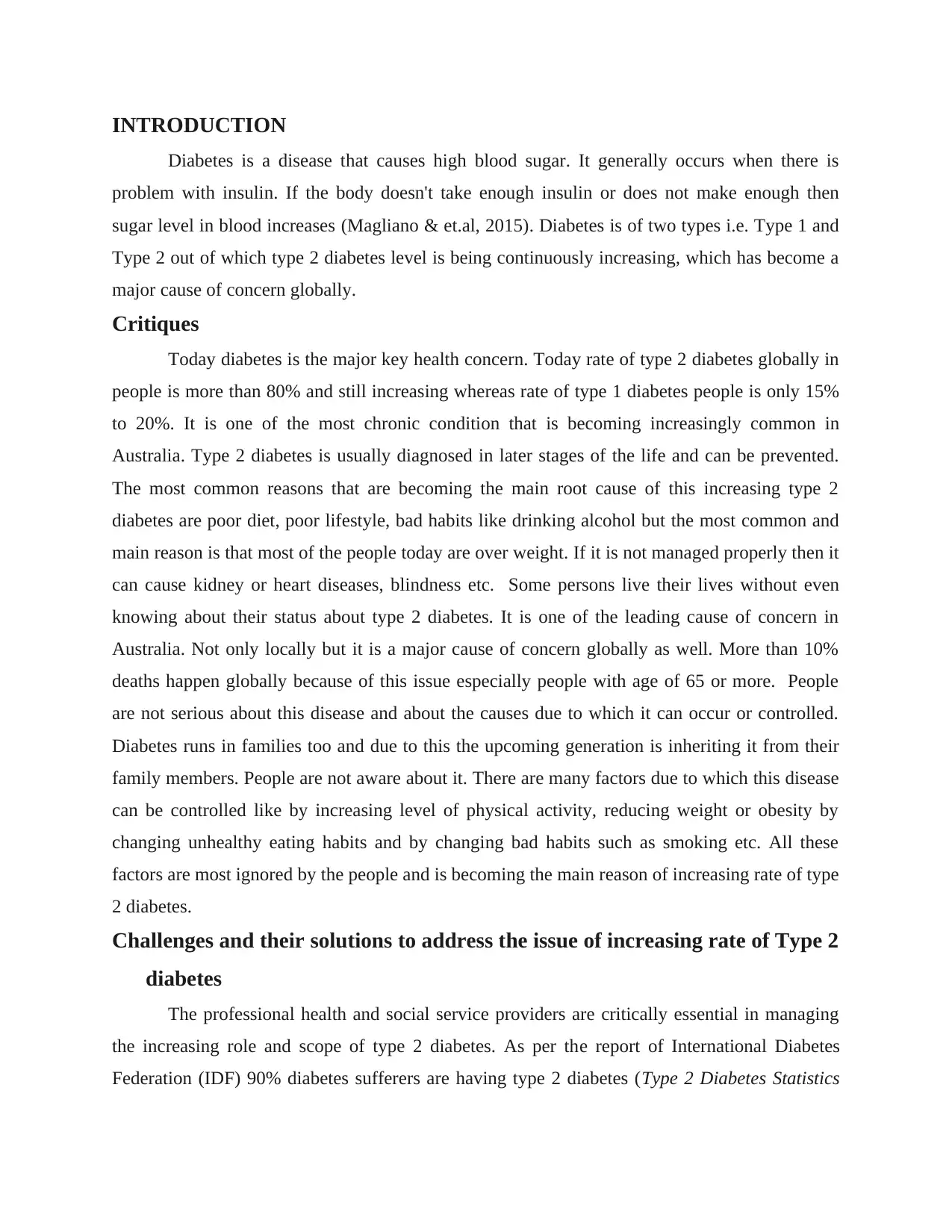
INTRODUCTION
Diabetes is a disease that causes high blood sugar. It generally occurs when there is
problem with insulin. If the body doesn't take enough insulin or does not make enough then
sugar level in blood increases (Magliano & et.al, 2015). Diabetes is of two types i.e. Type 1 and
Type 2 out of which type 2 diabetes level is being continuously increasing, which has become a
major cause of concern globally.
Critiques
Today diabetes is the major key health concern. Today rate of type 2 diabetes globally in
people is more than 80% and still increasing whereas rate of type 1 diabetes people is only 15%
to 20%. It is one of the most chronic condition that is becoming increasingly common in
Australia. Type 2 diabetes is usually diagnosed in later stages of the life and can be prevented.
The most common reasons that are becoming the main root cause of this increasing type 2
diabetes are poor diet, poor lifestyle, bad habits like drinking alcohol but the most common and
main reason is that most of the people today are over weight. If it is not managed properly then it
can cause kidney or heart diseases, blindness etc. Some persons live their lives without even
knowing about their status about type 2 diabetes. It is one of the leading cause of concern in
Australia. Not only locally but it is a major cause of concern globally as well. More than 10%
deaths happen globally because of this issue especially people with age of 65 or more. People
are not serious about this disease and about the causes due to which it can occur or controlled.
Diabetes runs in families too and due to this the upcoming generation is inheriting it from their
family members. People are not aware about it. There are many factors due to which this disease
can be controlled like by increasing level of physical activity, reducing weight or obesity by
changing unhealthy eating habits and by changing bad habits such as smoking etc. All these
factors are most ignored by the people and is becoming the main reason of increasing rate of type
2 diabetes.
Challenges and their solutions to address the issue of increasing rate of Type 2
diabetes
The professional health and social service providers are critically essential in managing
the increasing role and scope of type 2 diabetes. As per the report of International Diabetes
Federation (IDF) 90% diabetes sufferers are having type 2 diabetes (Type 2 Diabetes Statistics
Diabetes is a disease that causes high blood sugar. It generally occurs when there is
problem with insulin. If the body doesn't take enough insulin or does not make enough then
sugar level in blood increases (Magliano & et.al, 2015). Diabetes is of two types i.e. Type 1 and
Type 2 out of which type 2 diabetes level is being continuously increasing, which has become a
major cause of concern globally.
Critiques
Today diabetes is the major key health concern. Today rate of type 2 diabetes globally in
people is more than 80% and still increasing whereas rate of type 1 diabetes people is only 15%
to 20%. It is one of the most chronic condition that is becoming increasingly common in
Australia. Type 2 diabetes is usually diagnosed in later stages of the life and can be prevented.
The most common reasons that are becoming the main root cause of this increasing type 2
diabetes are poor diet, poor lifestyle, bad habits like drinking alcohol but the most common and
main reason is that most of the people today are over weight. If it is not managed properly then it
can cause kidney or heart diseases, blindness etc. Some persons live their lives without even
knowing about their status about type 2 diabetes. It is one of the leading cause of concern in
Australia. Not only locally but it is a major cause of concern globally as well. More than 10%
deaths happen globally because of this issue especially people with age of 65 or more. People
are not serious about this disease and about the causes due to which it can occur or controlled.
Diabetes runs in families too and due to this the upcoming generation is inheriting it from their
family members. People are not aware about it. There are many factors due to which this disease
can be controlled like by increasing level of physical activity, reducing weight or obesity by
changing unhealthy eating habits and by changing bad habits such as smoking etc. All these
factors are most ignored by the people and is becoming the main reason of increasing rate of type
2 diabetes.
Challenges and their solutions to address the issue of increasing rate of Type 2
diabetes
The professional health and social service providers are critically essential in managing
the increasing role and scope of type 2 diabetes. As per the report of International Diabetes
Federation (IDF) 90% diabetes sufferers are having type 2 diabetes (Type 2 Diabetes Statistics
⊘ This is a preview!⊘
Do you want full access?
Subscribe today to unlock all pages.

Trusted by 1+ million students worldwide
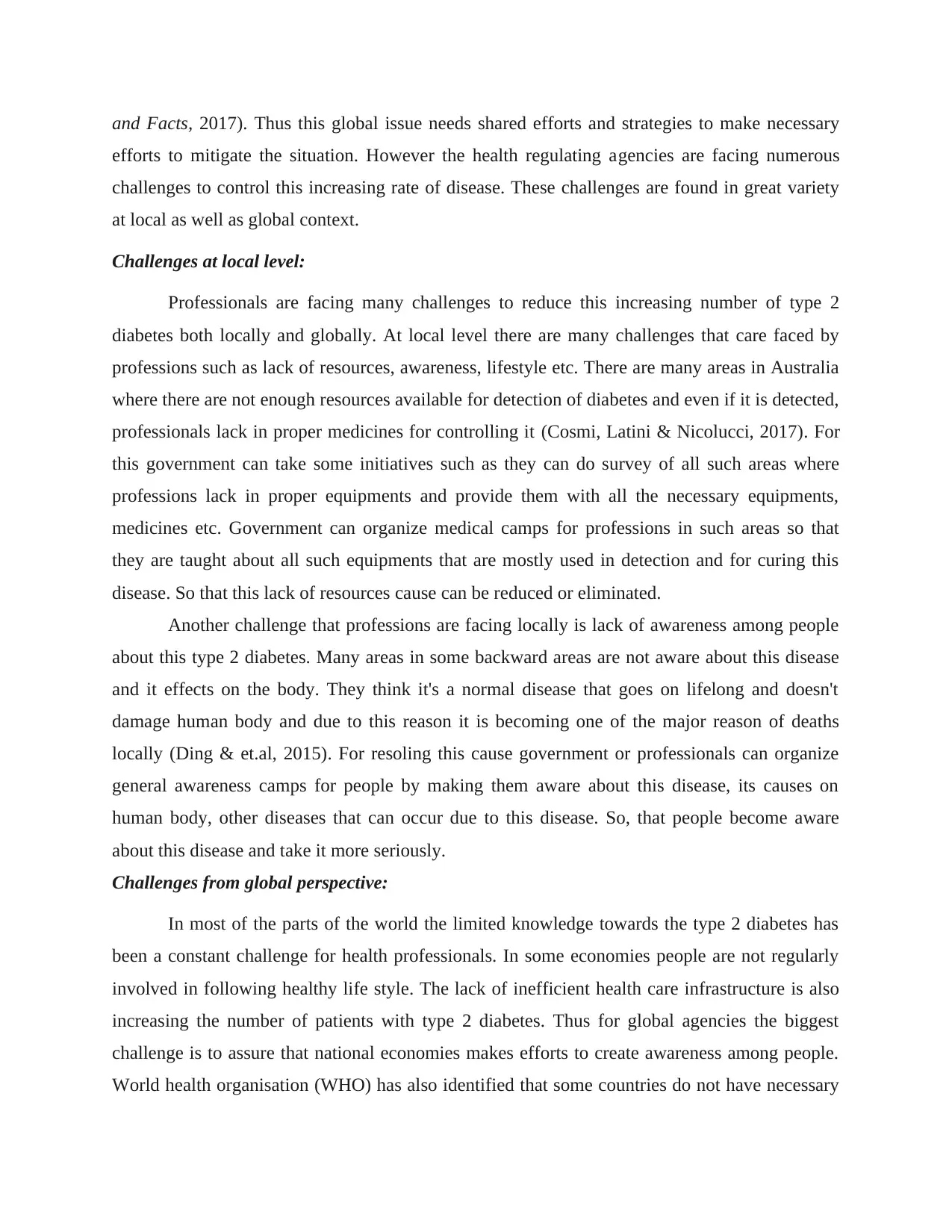
and Facts, 2017). Thus this global issue needs shared efforts and strategies to make necessary
efforts to mitigate the situation. However the health regulating agencies are facing numerous
challenges to control this increasing rate of disease. These challenges are found in great variety
at local as well as global context.
Challenges at local level:
Professionals are facing many challenges to reduce this increasing number of type 2
diabetes both locally and globally. At local level there are many challenges that care faced by
professions such as lack of resources, awareness, lifestyle etc. There are many areas in Australia
where there are not enough resources available for detection of diabetes and even if it is detected,
professionals lack in proper medicines for controlling it (Cosmi, Latini & Nicolucci, 2017). For
this government can take some initiatives such as they can do survey of all such areas where
professions lack in proper equipments and provide them with all the necessary equipments,
medicines etc. Government can organize medical camps for professions in such areas so that
they are taught about all such equipments that are mostly used in detection and for curing this
disease. So that this lack of resources cause can be reduced or eliminated.
Another challenge that professions are facing locally is lack of awareness among people
about this type 2 diabetes. Many areas in some backward areas are not aware about this disease
and it effects on the body. They think it's a normal disease that goes on lifelong and doesn't
damage human body and due to this reason it is becoming one of the major reason of deaths
locally (Ding & et.al, 2015). For resoling this cause government or professionals can organize
general awareness camps for people by making them aware about this disease, its causes on
human body, other diseases that can occur due to this disease. So, that people become aware
about this disease and take it more seriously.
Challenges from global perspective:
In most of the parts of the world the limited knowledge towards the type 2 diabetes has
been a constant challenge for health professionals. In some economies people are not regularly
involved in following healthy life style. The lack of inefficient health care infrastructure is also
increasing the number of patients with type 2 diabetes. Thus for global agencies the biggest
challenge is to assure that national economies makes efforts to create awareness among people.
World health organisation (WHO) has also identified that some countries do not have necessary
efforts to mitigate the situation. However the health regulating agencies are facing numerous
challenges to control this increasing rate of disease. These challenges are found in great variety
at local as well as global context.
Challenges at local level:
Professionals are facing many challenges to reduce this increasing number of type 2
diabetes both locally and globally. At local level there are many challenges that care faced by
professions such as lack of resources, awareness, lifestyle etc. There are many areas in Australia
where there are not enough resources available for detection of diabetes and even if it is detected,
professionals lack in proper medicines for controlling it (Cosmi, Latini & Nicolucci, 2017). For
this government can take some initiatives such as they can do survey of all such areas where
professions lack in proper equipments and provide them with all the necessary equipments,
medicines etc. Government can organize medical camps for professions in such areas so that
they are taught about all such equipments that are mostly used in detection and for curing this
disease. So that this lack of resources cause can be reduced or eliminated.
Another challenge that professions are facing locally is lack of awareness among people
about this type 2 diabetes. Many areas in some backward areas are not aware about this disease
and it effects on the body. They think it's a normal disease that goes on lifelong and doesn't
damage human body and due to this reason it is becoming one of the major reason of deaths
locally (Ding & et.al, 2015). For resoling this cause government or professionals can organize
general awareness camps for people by making them aware about this disease, its causes on
human body, other diseases that can occur due to this disease. So, that people become aware
about this disease and take it more seriously.
Challenges from global perspective:
In most of the parts of the world the limited knowledge towards the type 2 diabetes has
been a constant challenge for health professionals. In some economies people are not regularly
involved in following healthy life style. The lack of inefficient health care infrastructure is also
increasing the number of patients with type 2 diabetes. Thus for global agencies the biggest
challenge is to assure that national economies makes efforts to create awareness among people.
World health organisation (WHO) has also identified that some countries do not have necessary
Paraphrase This Document
Need a fresh take? Get an instant paraphrase of this document with our AI Paraphraser
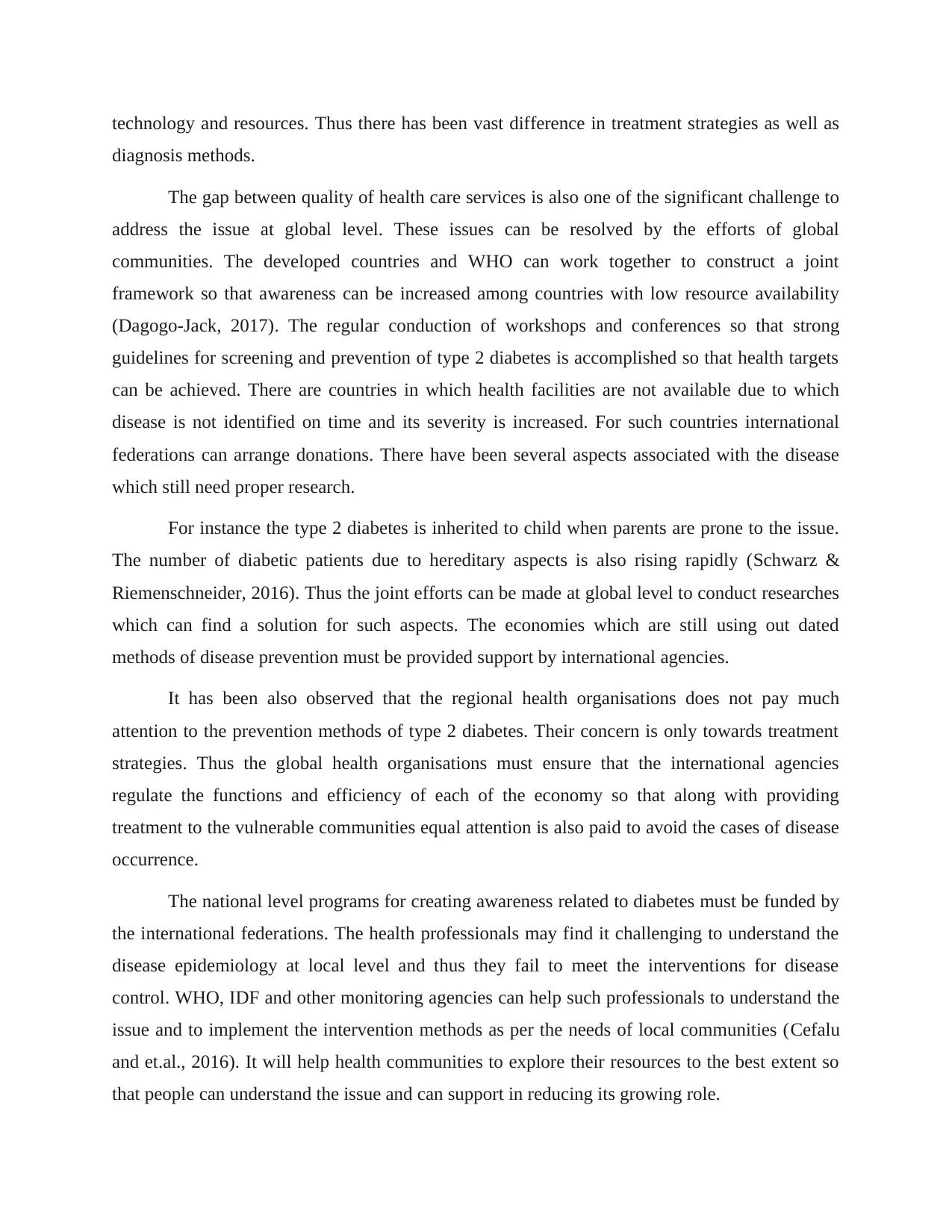
technology and resources. Thus there has been vast difference in treatment strategies as well as
diagnosis methods.
The gap between quality of health care services is also one of the significant challenge to
address the issue at global level. These issues can be resolved by the efforts of global
communities. The developed countries and WHO can work together to construct a joint
framework so that awareness can be increased among countries with low resource availability
(Dagogo-Jack, 2017). The regular conduction of workshops and conferences so that strong
guidelines for screening and prevention of type 2 diabetes is accomplished so that health targets
can be achieved. There are countries in which health facilities are not available due to which
disease is not identified on time and its severity is increased. For such countries international
federations can arrange donations. There have been several aspects associated with the disease
which still need proper research.
For instance the type 2 diabetes is inherited to child when parents are prone to the issue.
The number of diabetic patients due to hereditary aspects is also rising rapidly (Schwarz &
Riemenschneider, 2016). Thus the joint efforts can be made at global level to conduct researches
which can find a solution for such aspects. The economies which are still using out dated
methods of disease prevention must be provided support by international agencies.
It has been also observed that the regional health organisations does not pay much
attention to the prevention methods of type 2 diabetes. Their concern is only towards treatment
strategies. Thus the global health organisations must ensure that the international agencies
regulate the functions and efficiency of each of the economy so that along with providing
treatment to the vulnerable communities equal attention is also paid to avoid the cases of disease
occurrence.
The national level programs for creating awareness related to diabetes must be funded by
the international federations. The health professionals may find it challenging to understand the
disease epidemiology at local level and thus they fail to meet the interventions for disease
control. WHO, IDF and other monitoring agencies can help such professionals to understand the
issue and to implement the intervention methods as per the needs of local communities (Cefalu
and et.al., 2016). It will help health communities to explore their resources to the best extent so
that people can understand the issue and can support in reducing its growing role.
diagnosis methods.
The gap between quality of health care services is also one of the significant challenge to
address the issue at global level. These issues can be resolved by the efforts of global
communities. The developed countries and WHO can work together to construct a joint
framework so that awareness can be increased among countries with low resource availability
(Dagogo-Jack, 2017). The regular conduction of workshops and conferences so that strong
guidelines for screening and prevention of type 2 diabetes is accomplished so that health targets
can be achieved. There are countries in which health facilities are not available due to which
disease is not identified on time and its severity is increased. For such countries international
federations can arrange donations. There have been several aspects associated with the disease
which still need proper research.
For instance the type 2 diabetes is inherited to child when parents are prone to the issue.
The number of diabetic patients due to hereditary aspects is also rising rapidly (Schwarz &
Riemenschneider, 2016). Thus the joint efforts can be made at global level to conduct researches
which can find a solution for such aspects. The economies which are still using out dated
methods of disease prevention must be provided support by international agencies.
It has been also observed that the regional health organisations does not pay much
attention to the prevention methods of type 2 diabetes. Their concern is only towards treatment
strategies. Thus the global health organisations must ensure that the international agencies
regulate the functions and efficiency of each of the economy so that along with providing
treatment to the vulnerable communities equal attention is also paid to avoid the cases of disease
occurrence.
The national level programs for creating awareness related to diabetes must be funded by
the international federations. The health professionals may find it challenging to understand the
disease epidemiology at local level and thus they fail to meet the interventions for disease
control. WHO, IDF and other monitoring agencies can help such professionals to understand the
issue and to implement the intervention methods as per the needs of local communities (Cefalu
and et.al., 2016). It will help health communities to explore their resources to the best extent so
that people can understand the issue and can support in reducing its growing role.

CONCLUSION
It can be concluded from the above discussion that the common good cannot be achieved
until and unless the professional communities does not share their responsibilities at local as well
as global level.
It can be concluded from the above discussion that the common good cannot be achieved
until and unless the professional communities does not share their responsibilities at local as well
as global level.
⊘ This is a preview!⊘
Do you want full access?
Subscribe today to unlock all pages.

Trusted by 1+ million students worldwide
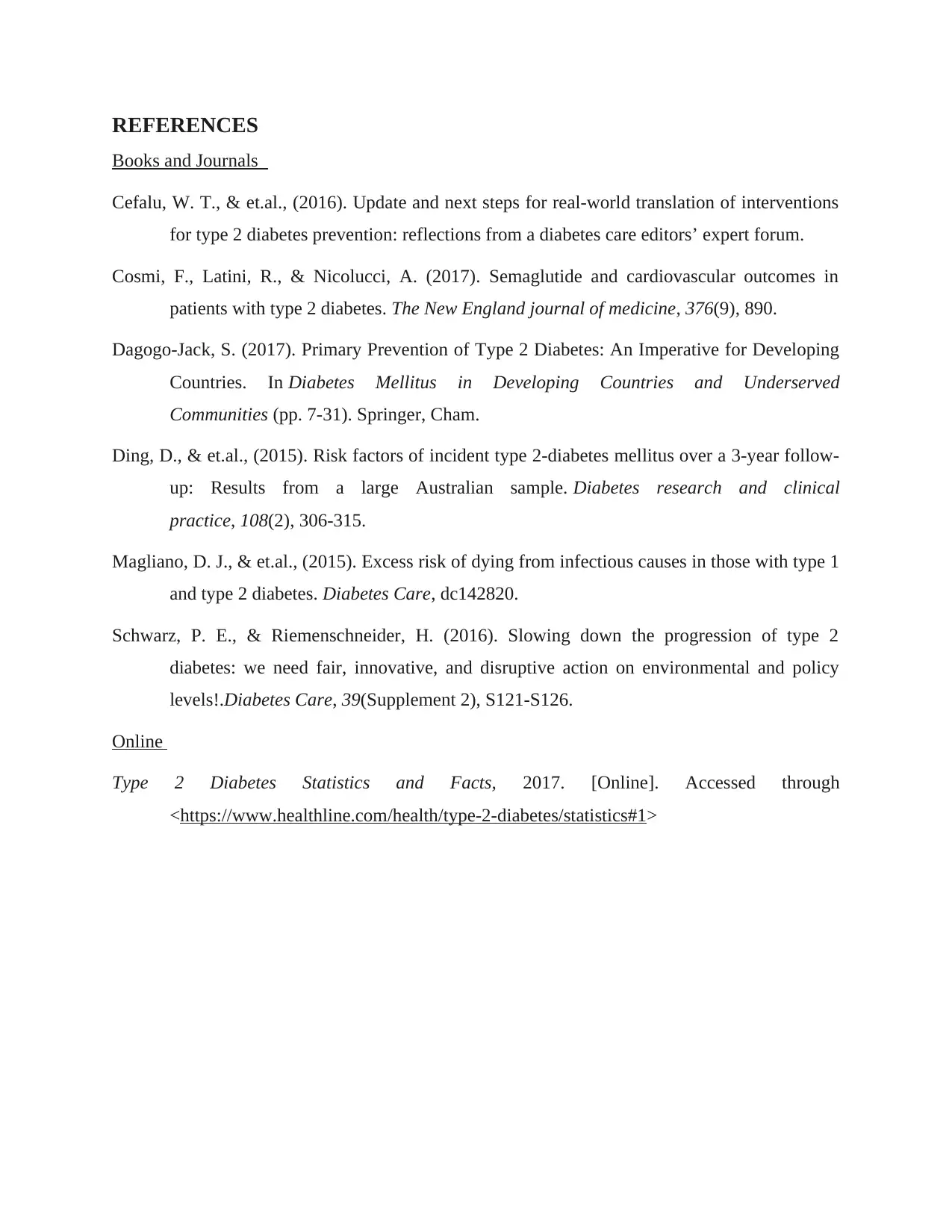
REFERENCES
Books and Journals
Cefalu, W. T., & et.al., (2016). Update and next steps for real-world translation of interventions
for type 2 diabetes prevention: reflections from a diabetes care editors’ expert forum.
Cosmi, F., Latini, R., & Nicolucci, A. (2017). Semaglutide and cardiovascular outcomes in
patients with type 2 diabetes. The New England journal of medicine, 376(9), 890.
Dagogo-Jack, S. (2017). Primary Prevention of Type 2 Diabetes: An Imperative for Developing
Countries. In Diabetes Mellitus in Developing Countries and Underserved
Communities (pp. 7-31). Springer, Cham.
Ding, D., & et.al., (2015). Risk factors of incident type 2-diabetes mellitus over a 3-year follow-
up: Results from a large Australian sample. Diabetes research and clinical
practice, 108(2), 306-315.
Magliano, D. J., & et.al., (2015). Excess risk of dying from infectious causes in those with type 1
and type 2 diabetes. Diabetes Care, dc142820.
Schwarz, P. E., & Riemenschneider, H. (2016). Slowing down the progression of type 2
diabetes: we need fair, innovative, and disruptive action on environmental and policy
levels!.Diabetes Care, 39(Supplement 2), S121-S126.
Online
Type 2 Diabetes Statistics and Facts, 2017. [Online]. Accessed through
<https://www.healthline.com/health/type-2-diabetes/statistics#1>
Books and Journals
Cefalu, W. T., & et.al., (2016). Update and next steps for real-world translation of interventions
for type 2 diabetes prevention: reflections from a diabetes care editors’ expert forum.
Cosmi, F., Latini, R., & Nicolucci, A. (2017). Semaglutide and cardiovascular outcomes in
patients with type 2 diabetes. The New England journal of medicine, 376(9), 890.
Dagogo-Jack, S. (2017). Primary Prevention of Type 2 Diabetes: An Imperative for Developing
Countries. In Diabetes Mellitus in Developing Countries and Underserved
Communities (pp. 7-31). Springer, Cham.
Ding, D., & et.al., (2015). Risk factors of incident type 2-diabetes mellitus over a 3-year follow-
up: Results from a large Australian sample. Diabetes research and clinical
practice, 108(2), 306-315.
Magliano, D. J., & et.al., (2015). Excess risk of dying from infectious causes in those with type 1
and type 2 diabetes. Diabetes Care, dc142820.
Schwarz, P. E., & Riemenschneider, H. (2016). Slowing down the progression of type 2
diabetes: we need fair, innovative, and disruptive action on environmental and policy
levels!.Diabetes Care, 39(Supplement 2), S121-S126.
Online
Type 2 Diabetes Statistics and Facts, 2017. [Online]. Accessed through
<https://www.healthline.com/health/type-2-diabetes/statistics#1>
1 out of 7
Related Documents
Your All-in-One AI-Powered Toolkit for Academic Success.
+13062052269
info@desklib.com
Available 24*7 on WhatsApp / Email
![[object Object]](/_next/static/media/star-bottom.7253800d.svg)
Unlock your academic potential
Copyright © 2020–2025 A2Z Services. All Rights Reserved. Developed and managed by ZUCOL.





